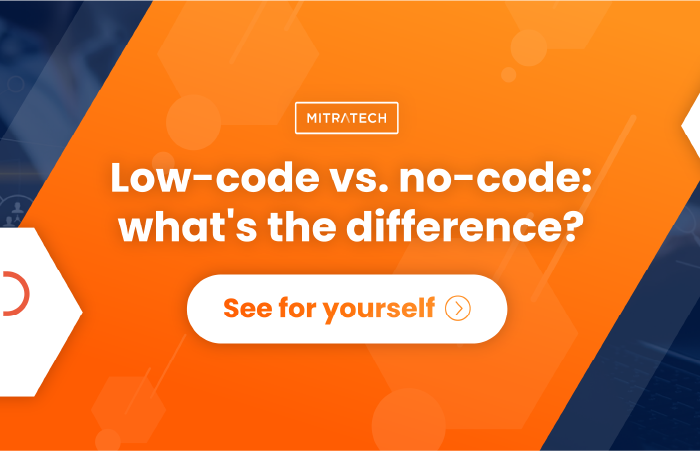No-Code Vs. Low-Code Automation: How to Spot the Difference
Many organizations are turning to low-code and no-code solutions to streamline their operations and stay ahead of the competition — what’s the difference, and which option is better for you?
Both low-code and no-code solutions have transformed the way people build solutions for their companies. Traditional coding can be time-consuming, resource-intensive, and often requires specialized technical expertise. Low-code and no-code solutions, on the other hand, empower non-technical users to become creators, reducing the reliance on IT departments and accelerating application development. So, it’s no surprise that by 2025, a staggering 70% of new applications are predicted to be created using low-code or no-code platforms, (compared with under 25% in 2020).
But what is the difference between low-code and no-code solutions, and how can leaders decide which kind of platform makes the most sense for them?
What is low-code automation?
Low-code platforms provide a middle ground between manual coding and no-coding at all. While they streamline the development process and reduce the need for extensive coding, low-code solutions still rely on minimal coding knowledge.
What is no-code automation?
Unlike low-code, no-code solutions fully embrace accessibility, catering to a broader audience of non-technical users (or citizen developers) who can now contribute actively to the development process without the need for coding bootcamps or extensive training. These users often have business and process knowledge, but don’t know how to write code, so giving them the tools to make progress without IT or technical support can help drive efficiency, mitigate your IT backlog, increase autonomy, and foster a culture of innovation within organizations.
No-code platforms leverage intuitive drag-and-drop interfaces and pre-built components, enabling users to construct applications effortlessly, much like assembling building blocks. For example, imagine receiving a table from IKEA: you still have to follow the instructions and think through the construction, but everything you need for your final results is already in the box and you can execute on it yourself, rather than calling in an expert.
So, what is the difference between low-code and no-code?
Low-code and no-code solutions have revolutionized the way companies build applications, offering a departure from traditional coding practices. The primary distinction between them lies in the level of technical expertise required. But while low-code solutions still require some coding knowledge, no-code solutions are built for regular business users – including those who have never taken a coding bootcamp or spent a Sunday using youtube to figure out how to write an email with HTML. In other words, while both low code and no-code solutions help employees work faster and more efficiently, low-code still relies on coders, whereas no-code is for everyone. This democratization of app creation empowers individuals across different departments, such as HR, Legal, or Finance, to automate complex processes and build custom applications independently.
To code or not to code: which type of automation is better for you?
Whether you choose to deploy low-code or no-code solutions will often come down to your needs: while no-code allows more individuals to be involved in building and managing applications without the help of IT, low-code automation often allows for more coding extensibility (for specific functionalities) and customization.
One compelling reason why no-code solutions are capturing the imagination of business leaders is their potential to alleviate the burden of technical debt. Technical debt, the cost companies incur to maintain and fix code in applications, can be a substantial financial drain. On average, a company spends $3.61 per line of code, and with the average-size application comprising 300,000 lines of code, the expenses soar to a staggering $1,083,000 per application. By opting for no-code development, businesses can significantly minimize this expenditure, as the inherent simplicity of the no-code approach reduces the potential for errors and future maintenance costs.
However, as Senior Product Manager for TAP Workflow Automation, Brian Wardell, highlights, the conversation surrounding no-code and low-code often pits these functions against each other, when sometimes, a no-code platform will strategically include some low-code functionality. “While no-code is the best way to empower business users, sometimes low code can open up robust functionality to users that would otherwise be unavailable – for example, custom integrations with less common platforms. While we think that major integrations, such as Salesforce and DocuSign, should be “out of box” and easy for non-technical users to set up, we think that platforms should enable integrations with any platform with a REST API. So, although we build our products to be no-code, we leave a door open for custom integrations. When coding is needed, the projects tend to be manageable, and clients can outsource them to professionals or bring in coders in specified capacities.”
When looking for the right solutions, it’s important to make sure all of the tools you need are in the box, like:
- Pre-configured connections with your existing systems (like Salesforce, Microsoft Teams, etc.), so adoption doesn’t include one more login
- Built-in documentation to make it easy to understand and easy for new users to pick up
- Secure accessibility, so your 3rd parties, vendors, and customers can all collaborate

Accelerate your enterprise.
Transform your processes with best-in-class workflow automation.



